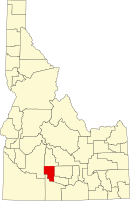Gooding County, Idaho
| Gooding County, Idaho | ||
|---|---|---|
|
||
 Location in the U.S. state of Idaho |
||
 Idaho's location in the U.S. |
||
| Founded | January 28, 1913 | |
| Named for | Frank R. Gooding | |
| Seat | Gooding | |
| Largest city | Gooding | |
| Area | ||
| • Total | 734 sq mi (1,901 km2) | |
| • Land | 729 sq mi (1,888 km2) | |
| • Water | 4.7 sq mi (12 km2), 0.6% | |
| Population | ||
| • (2010) | 15,464 | |
| • Density | 21/sq mi (8/km²) | |
| Congressional district | 2nd | |
| Time zone | Mountain: UTC-7/-6 | |
| Website | www |
|
Gooding County is a county located in the U.S. state of Idaho. As of the 2010 census, the population was 15,464. Its county seat is Gooding. The county was created by the Idaho Legislature on January 28, 1913, by a partition of Lincoln County. It is named for Frank R. Gooding, an early 20th Century governor and United States Senator from Idaho.
Almost 15,000 years ago, the Hagerman Valley was formed by the Bonneville Flood which deposited thousands of smooth boulders which can be seen on the surface of the valley floor today. After the Bonneville flood, Natives settled the area starting at least 12,000 years ago. Natives came into contact with emigrants on the Oregon Trail by 1840. The Oregon Trail traversed Gooding County with many emigrants stopping at Salmon Falls on the Snake River to barter fish with the native population. While Gooding County presently contains significant farming operations, it was the discovery of gold in 1862 that brought non-native settlement to the area. Mining settlement in the area was quite small in comparison to the rush to the Boise Valley occurring at the same time. The 1863 Census of Idaho Territory indicates there were 600 miners working Snake River mining operations, possibly covering the span of the river from the Hagerman Valley to Idaho Falls. Seven years later few people remained. A camp was sustained at Salmon Falls during 1870. The U.S. Census of 1870 enumerated 28 residents for "Overland Road and Snake River"
At the time of Snake River mining operations, the mining settlements were under the jurisdiction of Idaho County, Washington Territory. They were transferred to Boise County in 1863, becoming part of Alturas County at its creation in 1864. The railroad came through the area in the early 1880s with the Toponis railroad station being established by 1883. A post office was established there by 1887. The Toponis and Hagerman Valley settlements became part of Logan County at its creation in 1889. Logan county established the Bliss, Malad, and Toponis precincts containing 340 residents at the 1890 census. These precincts were transferred to Lincoln County at the first attempt to organize it in 1891. That act was found unconstitutional. In 1895 the precincts were transferred to Blaine County for a few days before ending up in Lincoln County. The arrival of the 20th Century brought a significant increase in settlement at Wendell and Toponis. Wendell incorporated in 1902. A town was platted on land owned by Frank R. Gooding at the Toponis rail station in 1907 and incorporated under the name of Gooding in 1908. The boom in settlement is clearly reflected when comparing 1900 and 1910 U.S. Census data. From 1900 to 1910, the Gooding precinct posted a 931% increase over the population listed for Toponis in 1900. The Clear Creek, Hagerman, and Wendell precincts were derived from the Malad precinct and posted a 509% increase over its 1900 population. Population growth was substantially lower at Bliss which only increased 42% over the 1900 population for the Bliss and Boulder Hill precincts. The only exception to the boom was for the sparsely populated Clover Creek precinct which saw a population decline. Overall, the precincts grew from 852 residents to 4,677 over that time frame--an increase of 448%.
...
Wikipedia

